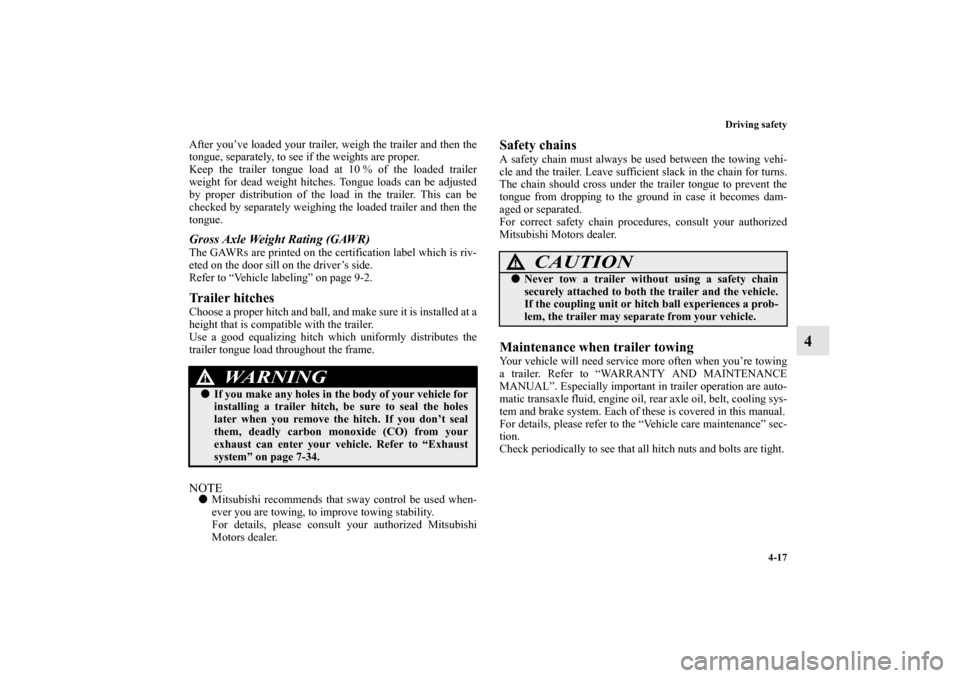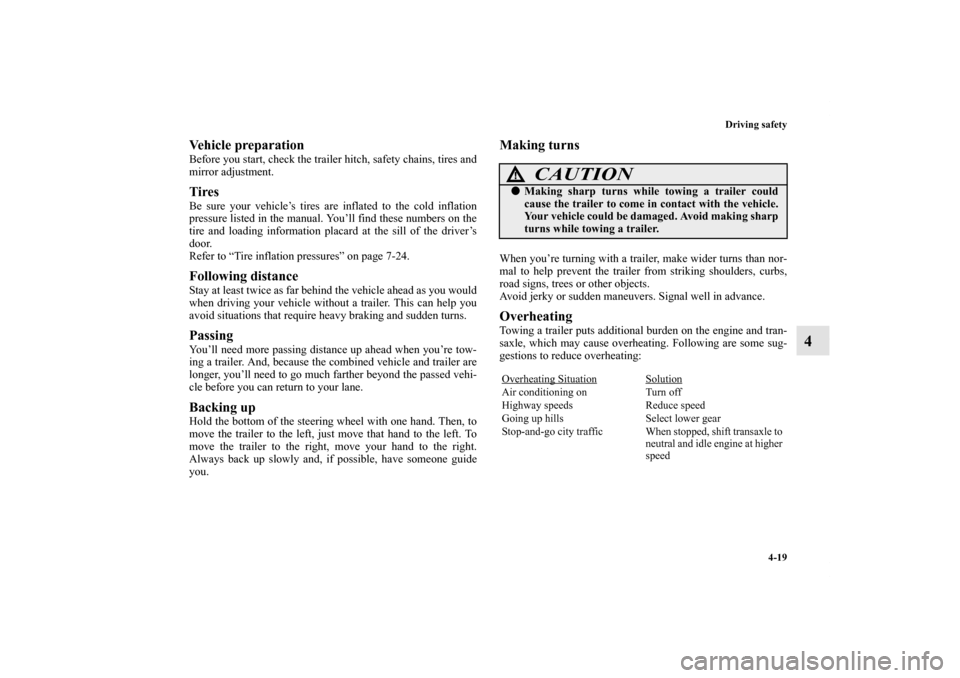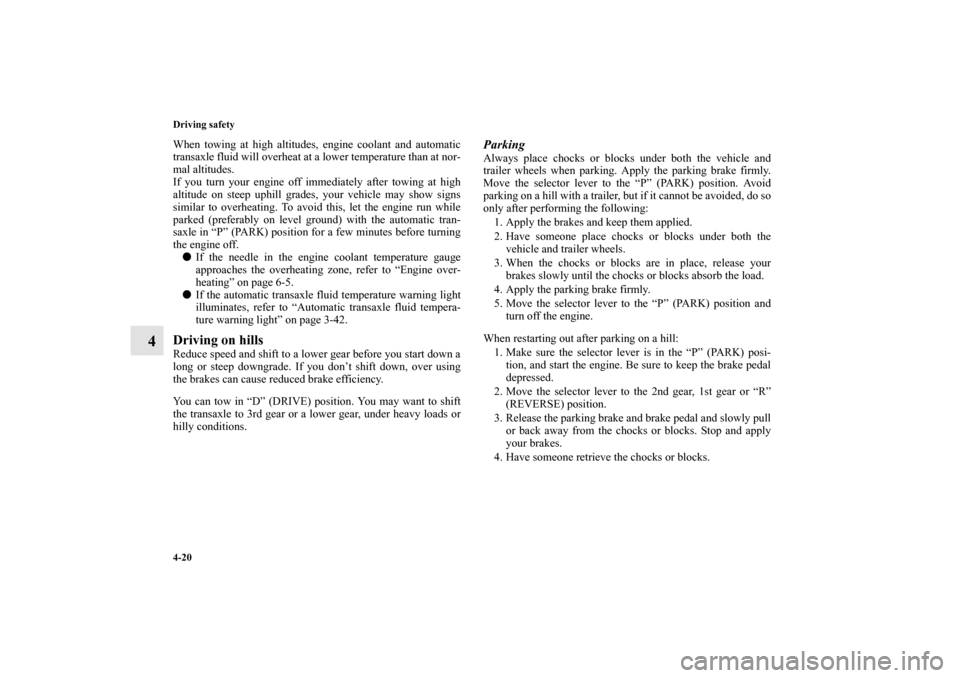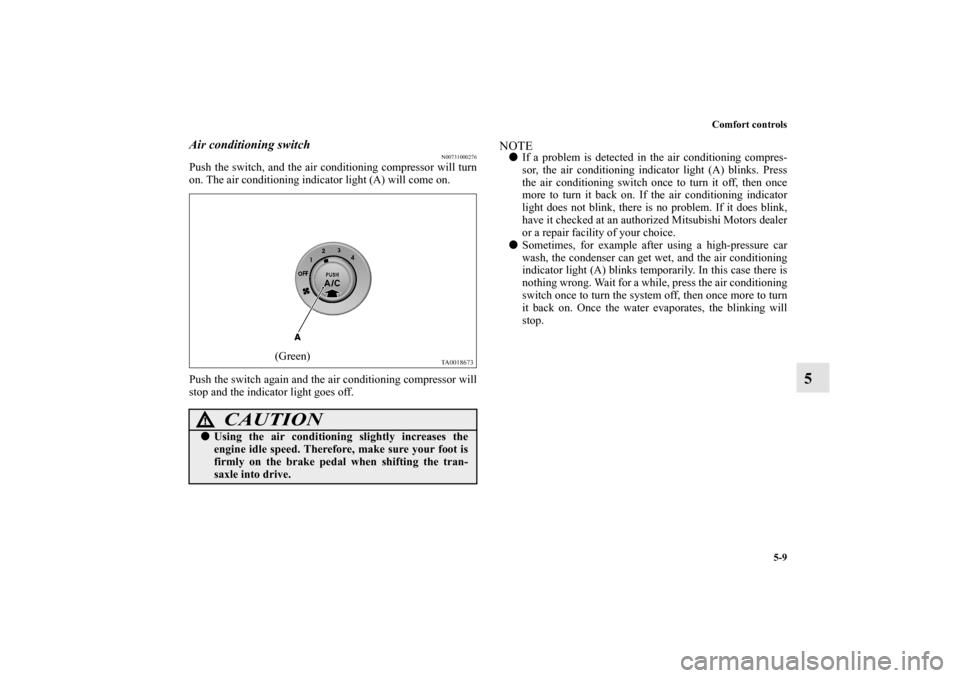Page 316 of 514

Driving safety
4-17
4
After you’ve loaded your trailer, weigh the trailer and then the
tongue, separately, to see if the weights are proper.
Keep the trailer tongue load at 10 % of the loaded trailer
weight for dead weight hitches. Tongue loads can be adjusted
by proper distribution of the load in the trailer. This can be
checked by separately weighing the loaded trailer and then the
tongue.Gross Axle Weight Rating (GAWR)The GAWRs are printed on the certification label which is riv-
eted on the door sill on the driver’s side.
Refer to “Vehicle labeling” on page 9-2.Trailer hitchesChoose a proper hitch and ball, and make sure it is installed at a
height that is compatible with the trailer.
Use a good equalizing hitch which uniformly distributes the
trailer tongue load throughout the frame.NOTE�Mitsubishi recommends that sway control be used when-
ever you are towing, to improve towing stability.
For details, please consult your authorized Mitsubishi
Motors dealer.
Safety chainsA safety chain must always be used between the towing vehi-
cle and the trailer. Leave sufficient slack in the chain for turns.
The chain should cross under the trailer tongue to prevent the
tongue from dropping to the ground in case it becomes dam-
aged or separated.
For correct safety chain procedures, consult your authorized
Mitsubishi Motors dealer.Maintenance when trailer towingYour vehicle will need service more often when you’re towing
a trailer. Refer to “WARRANTY AND MAINTENANCE
MANUAL”. Especially important in trailer operation are auto-
matic transaxle fluid, engine oil, rear axle oil, belt, cooling sys-
tem and brake system. Each of these is covered in this manual.
For details, please refer to the “Vehicle care maintenance” sec-
tion.
Check periodically to see that all hitch nuts and bolts are tight.
WA R N I N G
!�If you make any holes in the body of your vehicle for
installing a trailer hitch, be sure to seal the holes
later when you remove the hitch. If you don’t seal
them, deadly carbon monoxide (CO) from your
exhaust can enter your vehicle. Refer to “Exhaust
system” on page 7-34.
CAUTION
!�Never tow a trailer without using a safety chain
securely attached to both the trailer and the vehicle.
If the coupling unit or hitch ball experiences a prob-
lem, the trailer may separate from your vehicle.
BK0121600US.book 17 ページ 2010年4月12日 月曜日 午前10時39分
Page 318 of 514

Driving safety
4-19
4
Vehicle preparationBefore you start, check the trailer hitch, safety chains, tires and
mirror adjustment.TiresBe sure your vehicle’s tires are inflated to the cold inflation
pressure listed in the manual. You’ll find these numbers on the
tire and loading information placard at the sill of the driver’s
door.
Refer to “Tire inflation pressures” on page 7-24.Following distanceStay at least twice as far behind the vehicle ahead as you would
when driving your vehicle without a trailer. This can help you
avoid situations that require heavy braking and sudden turns.PassingYou’ll need more passing distance up ahead when you’re tow-
ing a trailer. And, because the combined vehicle and trailer are
longer, you’ll need to go much farther beyond the passed vehi-
cle before you can return to your lane.Backing upHold the bottom of the steering wheel with one hand. Then, to
move the trailer to the left, just move that hand to the left. To
move the trailer to the right, move your hand to the right.
Always back up slowly and, if possible, have someone guide
you.
Making turnsWhen you’re turning with a trailer, make wider turns than nor-
mal to help prevent the trailer from striking shoulders, curbs,
road signs, trees or other objects.
Avoid jerky or sudden maneuvers. Signal well in advance.OverheatingTowing a trailer puts additional burden on the engine and tran-
saxle, which may cause overheating. Following are some sug-
gestions to reduce overheating:
CAUTION
!�Making sharp turns while towing a trailer could
cause the trailer to come in contact with the vehicle.
Your vehicle could be damaged. Avoid making sharp
turns while towing a trailer. Overheating Situation
Solution
Air conditioning on Turn off
Highway speeds Reduce speed
Going up hills Select lower gear
Stop-and-go city traffic When stopped, shift transaxle to
neutral and idle engine at higher
speed
BK0121600US.book 19 ページ 2010年4月12日 月曜日 午前10時39分
Page 319 of 514

4-20 Driving safety
4
When towing at high altitudes, engine coolant and automatic
transaxle fluid will overheat at a lower temperature than at nor-
mal altitudes.
If you turn your engine off immediately after towing at high
altitude on steep uphill grades, your vehicle may show signs
similar to overheating. To avoid this, let the engine run while
parked (preferably on level ground) with the automatic tran-
saxle in “P” (PARK) position for a few minutes before turning
the engine off.
�If the needle in the engine coolant temperature gauge
approaches the overheating zone, refer to “Engine over-
heating” on page 6-5.
�If the automatic transaxle fluid temperature warning light
illuminates, refer to “Automatic transaxle fluid tempera-
ture warning light” on page 3-42.Driving on hillsReduce speed and shift to a lower gear before you start down a
long or steep downgrade. If you don’t shift down, over using
the brakes can cause reduced brake efficiency.
You can tow in “D” (DRIVE) position. You may want to shift
the transaxle to 3rd gear or a lower gear, under heavy loads or
hilly conditions.
ParkingAlways place chocks or blocks under both the vehicle and
trailer wheels when parking. Apply the parking brake firmly.
Move the selector lever to the “P” (PARK) position. Avoid
parking on a hill with a trailer, but if it cannot be avoided, do so
only after performing the following:
1. Apply the brakes and keep them applied.
2. Have someone place chocks or blocks under both the
vehicle and trailer wheels.
3. When the chocks or blocks are in place, release your
brakes slowly until the chocks or blocks absorb the load.
4. Apply the parking brake firmly.
5. Move the selector lever to the “P” (PARK) position and
turn off the engine.
When restarting out after parking on a hill:
1. Make sure the selector lever is in the “P” (PARK) posi-
tion, and start the engine. Be sure to keep the brake pedal
depressed.
2. Move the selector lever to the 2nd gear, 1st gear or “R”
(REVERSE) position.
3. Release the parking brake and brake pedal and slowly pull
or back away from the chocks or blocks. Stop and apply
your brakes.
4. Have someone retrieve the chocks or blocks.
BK0121600US.book 20 ページ 2010年4月12日 月曜日 午前10時39分
Page 325 of 514
5-6 Comfort controls
5Manual air conditioning
(if so equipped)
N00730300113
The air conditioning can only be used while the engine is run-
ning.Control panel
N00730500245
Blower speed selection dial
N00736500090
When the ignition key is in the ON position, select the blower
speed by turning the blower speed selection dial. The blower
speed will gradually increase as the dial is turned to the right.
When the blower speed selection dial is set to the “OFF” posi-
tion, all fan-driven airflow will stop.
1- Temperature control dial
2- Air selection switch
3- Blower speed selection dial
4- Air conditioning switch
5- Electric rear window defogger switch → P.3-163
6- Mode selection dial
BK0121600US.book 6 ページ 2010年4月12日 月曜日 午前10時39分
Page 326 of 514
Comfort controls
5-7
5
Temperature control dial
N00736600147
Turn the temperature control dial clockwise to make the air
warmer. Turn it counterclockwise to make the air cooler. NOTE�While the engine coolant temperature is low, the tempera-
ture of the air from the heater will be cool/cold until the
engine warms up, even if you have selected warm air with
the dial.
�For instructions on how to use the “MAX A/C” position
(A), see “For quick cooling” on page 5-10.
Mode selection dial
N00736700148
To change the position and amount of air flowing from the
vents, turn the mode selection dial. (Refer to “Changing the
mode selection” on page 5-3.)
BK0121600US.book 7 ページ 2010年4月12日 月曜日 午前10時39分
Page 328 of 514

Comfort controls
5-9
5
Air conditioning switch
N00731000276
Push the switch, and the air conditioning compressor will turn
on. The air conditioning indicator light (A) will come on.
Push the switch again and the air conditioning compressor will
stop and the indicator light goes off.
NOTE�If a problem is detected in the air conditioning compres-
sor, the air conditioning indicator light (A) blinks. Press
the air conditioning switch once to turn it off, then once
more to turn it back on. If the air conditioning indicator
light does not blink, there is no problem. If it does blink,
have it checked at an authorized Mitsubishi Motors dealer
or a repair facility of your choice.
�Sometimes, for example after using a high-pressure car
wash, the condenser can get wet, and the air conditioning
indicator light (A) blinks temporarily. In this case there is
nothing wrong. Wait for a while, press the air conditioning
switch once to turn the system off, then once more to turn
it back on. Once the water evaporates, the blinking will
stop.
CAUTION
!�Using the air conditioning slightly increases the
engine idle speed. Therefore, make sure your foot is
firmly on the brake pedal when shifting the tran-
saxle into drive.
(Green)
BK0121600US.book 9 ページ 2010年4月12日 月曜日 午前10時39分
Page 333 of 514
5-14 Comfort controls
5Automatic air conditioning
(if so equipped)
N00731500082
The air conditioning can only be used while the engine is run-
ning.Control panel
N00711800441
Ty p e 1
1- Temperature control dial
2- Air selection switch
3- Blower speed selection dial
4- Air conditioning switch
5- Electric rear window defogger switch → P.3-163
6- Mode selection dialTy p e 2
BK0121600US.book 14 ページ 2010年4月12日 月曜日 午前10時39分
Page 337 of 514
5-18 Comfort controls
5
NOTE�While the engine coolant temperature is low, the tempera-
ture of the air from the heater will be cool/cold until the
engine warms up, even if you have selected warm air with
the dial.
Mode selection dial
N00737100123
To change the position and amount of air flowing from the
vents, turn the mode selection dial. (Refer to “Changing the
mode selection” on page 5-3.)
BK0121600US.book 18 ページ 2010年4月12日 月曜日 午前10時39分